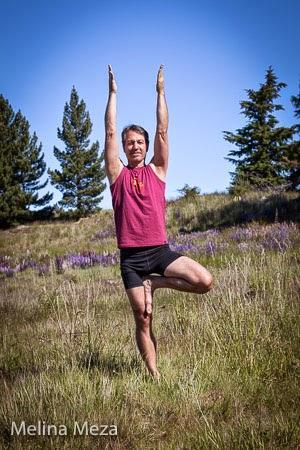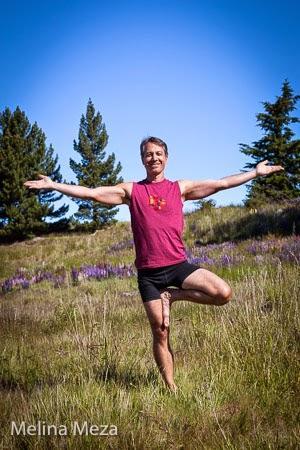 In preparation for my Yoga U Online webinar Yoga for Core Integrity and Balance that started last Tuesday and finishes this Thursday, December 18, 2014, I was reading two papers that shed some interesting light on why we should to be concerned about balance and how to improve it. The first was a 2008 study Shifting the focus in fracture prevention from osteoporosis to falls that appeared in the British Medical Journal, and the second was a 2008 paper Integrated Balance Training by the National Academy of Sports Medicine (NASM). Since balance is one of our four essential skills of Yoga for Healthy Aging, I was excited to read about these takes on how to best improve balance. And as I was hiking around New Zealand last week and doing some yoga outdoors, some of these ideas started to make more sense to me.
In preparation for my Yoga U Online webinar Yoga for Core Integrity and Balance that started last Tuesday and finishes this Thursday, December 18, 2014, I was reading two papers that shed some interesting light on why we should to be concerned about balance and how to improve it. The first was a 2008 study Shifting the focus in fracture prevention from osteoporosis to falls that appeared in the British Medical Journal, and the second was a 2008 paper Integrated Balance Training by the National Academy of Sports Medicine (NASM). Since balance is one of our four essential skills of Yoga for Healthy Aging, I was excited to read about these takes on how to best improve balance. And as I was hiking around New Zealand last week and doing some yoga outdoors, some of these ideas started to make more sense to me.Before I get to some of the unique recommendations for balance training from the NASM article, I want to share some other fascinating assertions the first group of researchers bring up for why balance training is so important as we age. The authors of the study on falling note this blockbuster fact:
“Numerous studies show that among older people falling, not osteoporosis, is the strongest risk factor for fracture.”
They also make a very interesting and important point:
“When a person falls, the type and severity of the fall (including fall height, energy, and direction) largely determine whether a fracture occurs.”
They point out that statistically a person whose dexascan numbers are higher by 1 Standard Deviation increases the chance of a fracture by about two times normal, whereas:
“By contrast, a sideways fall increases the risk of hip fracture three to five times, and when such a fall causes an impact to the greater trochanter of the proximal femur, hip fracture risk is raised about 30 times. These fall induced fracture risks are “strong” associations—comparable to those between smoking and lung cancer.”
To summarize what this study concluded:
- Falling, not osteoporosis, is the strongest single risk factor for fractures in elderly people
- Bone mineral density is a poor predictor of an individual’s fracture risk
- Drug treatment is expensive and will not prevent most fractures in elderly people
- Randomized controlled trials show that falls in older people can be reduced by up to 50% with balance training
This is where the second paper by the NASM comes in. It was specifically looking at providing a better understanding of the complexities of what goes into having good balance as well as how to train individuals to improve balance. There were two intriguing ideas presented that I want to share with you today.
The first has to do with a special approach to balance. According to the authors of this paper, “the main goal of balance training is to continually increase your client’s awareness of his or her balance threshold or limits of stability by creating controlled instability.” To give you a better idea of what they mean, they go on to define “balance threshold” as follows:
“Integrated (balance) training should constantly stress an individual’s limits of stability (balance threshold). An individual’s limits of stability are the distance outside of his or her base of support he or she can go without losing control of the center of gravity.”
This idea can apply to static poses as well as dynamic movements in your yoga practice. For yoga practitioners, this means that instead of merely doing our regular routine balance poses and dynamic sequences each day or week, we should consider challenging ourselves or our students by adding in “controlled instability.” Of course, you could try practicing your balance poses outside on uneven ground, as I did in New Zealand. That definitely adds some controlled instability!
 But even in the yoga room, you can use your creativity to add some instability into your practice. An example of this might be to move from doing Tree pose (Vrksasana) on the floor to trying it while standing on a wooden block on the lowest height, gradually working towards a longer hold of the pose there. So, the first time I try it, I might shoot for 30 seconds on each side. Once that seems stable and easy, perhaps after several days or a week of practice, I’d advance to 60 seconds. Once I’ve mastered that variable, I might then try the same thing on a slightly softer foam block. From there, I might add in the challenge of holding an additional block between my hands and dynamically moving it not just up and overhead as is sometimes more traditionally done, but taking over to the right side (not side bending, just angling the arms up and to the right), then the left side, then down and to the right and down and to the left while maintaining balance in Tree. As this example demonstrates, a certain amount of creativity will be involved in providing yourself with more challenges over time. Keep in mind that even small changes in the way you do your “normal” poses can add this element of “controlled instability” into your practice.
But even in the yoga room, you can use your creativity to add some instability into your practice. An example of this might be to move from doing Tree pose (Vrksasana) on the floor to trying it while standing on a wooden block on the lowest height, gradually working towards a longer hold of the pose there. So, the first time I try it, I might shoot for 30 seconds on each side. Once that seems stable and easy, perhaps after several days or a week of practice, I’d advance to 60 seconds. Once I’ve mastered that variable, I might then try the same thing on a slightly softer foam block. From there, I might add in the challenge of holding an additional block between my hands and dynamically moving it not just up and overhead as is sometimes more traditionally done, but taking over to the right side (not side bending, just angling the arms up and to the right), then the left side, then down and to the right and down and to the left while maintaining balance in Tree. As this example demonstrates, a certain amount of creativity will be involved in providing yourself with more challenges over time. Keep in mind that even small changes in the way you do your “normal” poses can add this element of “controlled instability” into your practice.As for dynamic sequencing, you might change up a Sun Salutation by adding in a pose you don’t normally do while flowing in and out of the usual sequence, such as, from transition from Lunge pose into Standing Splits (Urdhva Prasarita Eka Padasana) for a breath or two before stepping back to Lunge and onto Downward Dog and all the rest. When that new sequence gets easy to do in the flow, add in another pose that challenges your balance a bit more, and so on and so forth. Again, be creative and systematic in how you do this and have some fun with it!
Improving balance not only can reduce your chances of falling and therefore reduces your chance of a fractured bone, but it has also been shown to reduce the chances of other sorts of injuries as well, such as anterior cruciate ligament tears in the knees and ankle sprains. So start playing around with these ideas in your home practice or for the teachers out there, let these ideas add some more variety and creativity to your sequencing of classes. And as always, we love to hear what you discover along the way! Happy, balanced trails!
And for those want more details on these ideas, check out my Yoga U Online webinar. Part 2 is live this Thursday, December 18th, at 5:30PST, 8:30EST. Even if you missed Part 1 last week, it is now archived and if you sign up for the program (see yogauonline.com), you can listen and watch either one anytime you want. The package also includes a one-hour practice video on Core Integrity and Balance. The perfect holiday gift for yourself!
Subscribe to Yoga for Healthy Aging by Email ° Follow Yoga for Healthy Aging on Facebook ° Join this site with Google Friend Connect

